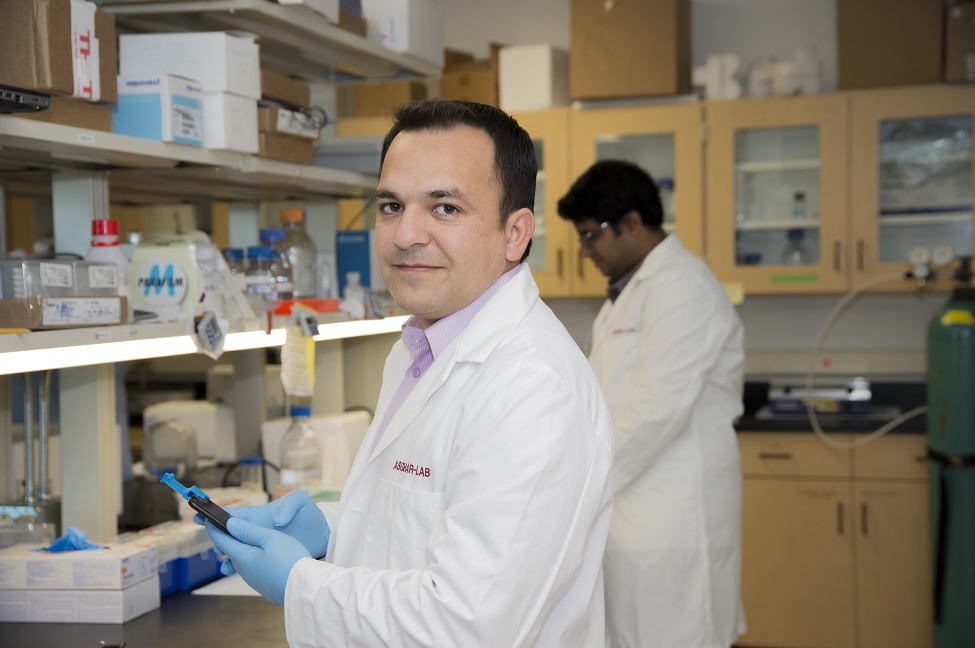Kit Promises 'Hassle Free' Way to Test Male Fertility

Waseem Asghar, Ph.D., is developing the kit to provide a complete analysis of male fertility at home that is private, rapid and cost-effective, making it especially beneficial to men who are hesitant to seek medical evaluation. (Photo by Alex Dolce)
It is estimated that of the 70 million cases of infertility worldwide, almost half are caused by factors relating to the male partner. A number of semen parameters – motility, morphology, velocity, volume, concentration, and count – affect male fertility. Are there enough of them? Are they fast swimmers? Are they shaped the right way? And, moreover, are they dead or alive? The only way to know for certain is through fertility testing.
Although men can get tested to determine their fertility potential, it typically involves bulky and expensive equipment that requires skilled technicians in a laboratory setting and lengthy wait times for results. These factors, not to mention lack of privacy, all hinder widespread use of fertility testing and contribute to the unwillingness of many men to get tested.
To address embarrassing, inconvenient and costly male fertility testing, researchers from Florida Atlantic University’s College of Engineering and Computer Science are developing a home-based kit that accurately, quantitatively, and quickly, provides a complete semen evaluation using microfluidics, an app and a smartphone. After all, if women can use pregnancy tests in the comfort and privacy of their own homes, men also should be able to test their semen at home without any hassles.
“Although there are a number of products available or being developed for home-based semen analysis, they only give users a general idea of their fertility based on some of the parameters and not the whole picture, which can lead to false negatives,” said Waseem Asghar, Ph.D., an assistant professor in the Department of Computer and Electrical Engineering and Computer Science in FAU’s College of Engineering and Computer Science, who also has a joint-appointment in the Department of Biological Sciences in FAU’s Charles E. Schmidt College of Science. “We are developing our kit to provide a complete analysis of male fertility at home that is private, rapid and cost-effective, making it especially beneficial to men who are hesitant to seek medical evaluation.”
Asghar is leveraging his vast expertise in microfluidics and cellphone-based technology centered on his work on In Vitro fertilization and HIV and Zika virus testing to develop the sperm testing kit. He has joined forces with Imadeldin Mahgoub, Ph.D., Tecore professor in FAU’s Department of Computer and Electrical Engineering and Computer Science and an expert on algorithms and tracking.
Asghar’s user-friendly sperm kit will cost less than $2 per kit to develop and will require just one tiny drop of fluid, containing between 5 to 10 million sperm cells. The kit is being developed to be compatible with all smartphone models, a downside of some of the current technologies. The kit will consist of a sperm scope, a lens that functions like a microscope that snaps onto the phone, and a microfluidic chamber that will be able to analyze semen at the “micron” scale. These components are built using high-tech 3-D printers in the Asghar Lab - Micro and Nanotechnology in Medicine at FAU.
Using the app, which will be included in the kit, Asghar’s technology will capture, record and analyze important details about the user’s semen. Easy-to-read results will be available in about one minute to inform the user whether or not he needs to seek further medical attention.
The semen analysis kit will require just one tiny drop of fluid, which contains between 5 to 10 million sperm cells.
The new sperm kit is particularly good news for the more than 33 million men who undergo vasectomy procedures and need to retest their semen to ensure the surgery’s success. In this case, focus is on quantity over quality, as the main parameter to test for is sperm concentration, which should be lower than 100,000 sperm per milliliter eight to 16 weeks following the procedure. Currently, the number of vasectomy patients who actually follow up is very low because of the inconvenience of testing.
“We want to be able to do everything that is done as standard testing in the laboratory with our home-based sperm testing kit,” said Asghar. “At-home testing is a valuable tool for determining fertility potential, especially for couples struggling with infertility as well as vasectomy patients. Men who are reluctant to seek conventional clinical testing due to high cost, long wait time, inconvenience, or social stigma might be more willing to use home-based sperm analysis kits, which overcome those problems.”
Asghar expects to have the home-based sperm kit prototype developed within a year and commercially available in about two years.
Asghar, corresponding author, and colleagues provide a comprehensive review of “Emerging Technologies for Home-based Semen Analysis,” in the journal Andrology. The article’s first author is Sydney Yu, a student at FAU High School and a National Merit Scholar semi-finalist.
-FAU-
Tags: faculty and staff | engineering | science | medicine | technology | research